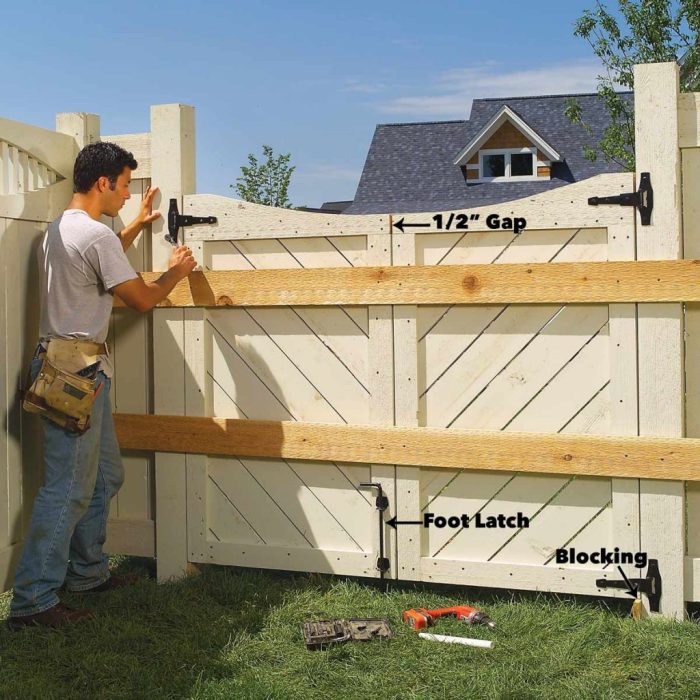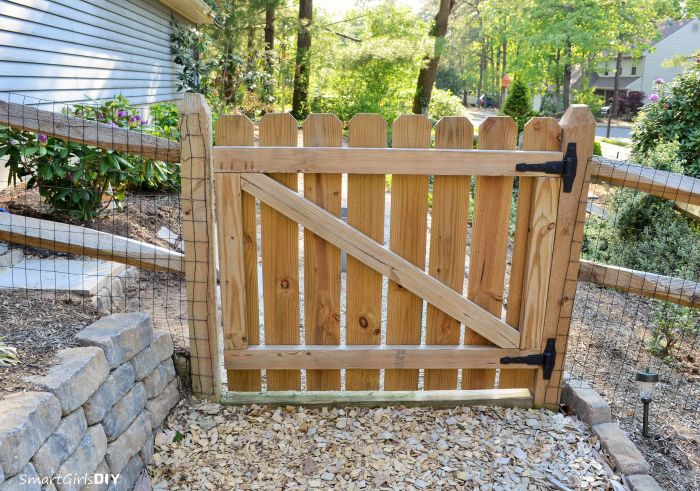DIY Fence and Gate: A Comprehensive Guide Embark on a journey to create a beautiful and functional fence and gate that enhances your property’s curb appeal and provides privacy and security. This guide provides a step-by-step process, from planning and design to construction and finishing touches, empowering you to build a fence and gate that reflects your unique style.
From choosing the right materials to understanding safety precautions, this guide covers everything you need to know to successfully complete your DIY fence and gate project. We’ll explore various fence types, including picket, privacy, rail, and split rail, discussing their advantages, disadvantages, and the materials used for each. You’ll also learn about designing a fence that complements your property’s style and creating a checklist for planning materials, tools, and equipment.
Choosing Materials

Choosing the right materials for your fence and gate is crucial for its durability, aesthetics, and overall cost. You’ll need to consider factors like your budget, the style you desire, the climate you live in, and the level of maintenance you’re willing to undertake.
Types of Fence Materials
The most common fence materials are wood, metal, and vinyl. Each material has its own set of pros and cons.
- Wood: Wood is a classic and versatile fence material that offers a natural look and feel. It’s relatively affordable and easy to work with, making it a popular choice for DIY projects. However, wood requires regular maintenance, including staining or painting, to prevent rot and insect damage.
- Metal: Metal fences are durable and low-maintenance. They come in various styles, including wrought iron, aluminum, and steel. Metal fences are resistant to pests and rot, but they can be more expensive than wood.
- Vinyl: Vinyl fences are a popular choice for their durability, low maintenance, and attractive appearance. They’re resistant to rot, insects, and fading. However, vinyl fences can be more expensive than wood and can be difficult to repair if damaged.
Choosing the Right Wood
If you’re opting for a wood fence, you’ll need to select the right type of wood for your project. Here are some popular choices:
- Cedar: Cedar is known for its natural resistance to rot and insects. It also has a pleasant aroma and a beautiful reddish-brown color. However, cedar can be more expensive than other wood types.
- Redwood: Redwood is another durable and naturally rot-resistant wood. It has a rich reddish-brown color and a distinctive grain pattern. Redwood is also more expensive than other wood types.
- Pressure-Treated Lumber: Pressure-treated lumber is a cost-effective option for fences. It’s treated with chemicals to resist rot and insects. However, pressure-treated lumber can have a greenish tint and may not be as aesthetically pleasing as cedar or redwood.
Selecting the Right Size and Quality
The size and quality of your fence materials will depend on the height and length of your fence, as well as the style you’re aiming for. It’s important to choose materials that are strong and durable enough to withstand the elements and potential damage.
- Fence Posts: Fence posts should be made of durable material like cedar, redwood, or pressure-treated lumber. The size of the posts will depend on the height of your fence.
- Fence Rails: Fence rails should be made of strong and durable wood, like cedar or redwood. The thickness of the rails will depend on the height and style of your fence.
- Fence Pickets: Fence pickets can be made of wood, metal, or vinyl. The size and spacing of the pickets will depend on the style of your fence.
Comparing Fence Materials
Here’s a table comparing different fence materials based on factors like cost, durability, maintenance, and aesthetics:
| Material | Cost | Durability | Maintenance | Aesthetics |
|---|---|---|---|---|
| Wood | Low to Moderate | Moderate | High | Natural and Versatile |
| Metal | Moderate to High | High | Low | Modern and Sleek |
| Vinyl | High | High | Very Low | Clean and Modern |
Safety Considerations: Diy Fence And Gate
Building a fence and gate is a rewarding project, but it’s essential to prioritize safety throughout the process. Working with power tools and sharp objects can be dangerous if proper precautions aren’t taken.
Safety Equipment, Diy fence and gate
Wearing appropriate safety gear is crucial for protecting yourself from potential hazards.
- Safety Glasses: Protect your eyes from flying debris and sawdust.
- Hearing Protection: Power tools can generate loud noise, so earplugs or earmuffs are essential for preventing hearing damage.
- Gloves: Protect your hands from splinters, cuts, and abrasions.
- Work Boots: Sturdy work boots with steel toes provide protection for your feet.
- Dust Mask: A dust mask helps filter out harmful particles, especially when working with wood.
Power Tool Safety
Power tools can be incredibly useful, but they also pose risks if not handled correctly.
- Read the Manual: Always read the instruction manual for each power tool before using it. Familiarize yourself with its features, safety precautions, and operating procedures.
- Inspect Tools: Before each use, check the power cord for damage, ensure the blades are sharp and secure, and confirm all guards are in place.
- Keep Tools Clean: Regularly clean and maintain your power tools. This will help them operate smoothly and reduce the risk of malfunctions.
- Avoid Distractions: When using power tools, focus your attention on the task at hand. Avoid distractions, and never use tools while under the influence of alcohol or drugs.
- Use the Right Tool: Choose the appropriate power tool for the job. Don’t try to use a tool for a purpose it wasn’t designed for.
General Safety Tips
Following general safety tips can help minimize the risk of accidents during your fence and gate construction project.
- Clear the Work Area: Remove any obstacles or debris from the work area to prevent tripping or falls.
- Secure Materials: Properly secure materials, such as lumber and tools, to prevent them from falling or rolling.
- Use a Ladder Safely: When working at heights, always use a sturdy ladder and follow safe ladder practices. Never overreach or stand on the top rung of a ladder.
- Take Breaks: Take regular breaks to avoid fatigue, which can increase the risk of accidents.
- Ask for Help: If you’re unsure about a task or need assistance, don’t hesitate to ask for help from a qualified professional.
Building Codes and Regulations
It’s crucial to comply with local building codes and regulations when constructing a fence or gate. These codes are designed to ensure the safety and stability of structures.
- Check Local Codes: Contact your local building department to obtain copies of the relevant building codes for fences and gates.
- Height Restrictions: Building codes often specify height restrictions for fences based on location and property lines.
- Material Requirements: Codes may dictate the types of materials that can be used for fence construction, such as the minimum thickness of wood or the type of metal.
- Permit Requirements: In some areas, you may need to obtain a permit before starting construction. Check with your local building department to determine if a permit is required.
Creative Ideas and Designs

A DIY fence and gate can be much more than just a functional barrier. It can be a beautiful and creative addition to your property, reflecting your personal style and enhancing the overall aesthetic. With a little imagination and effort, you can transform your fence and gate into a stunning focal point that complements your landscaping and creates a welcoming atmosphere.
Unique and Creative DIY Fence and Gate Designs
There are endless possibilities when it comes to designing a unique fence and gate. Consider incorporating these elements:
- Rustic Charm: Use reclaimed wood, weathered barn boards, or rough-hewn logs to create a rustic and natural look. You can add decorative touches like metal accents, wrought iron hinges, or antique-style hardware.
- Modern Minimalism: Opt for clean lines, simple geometric shapes, and a minimalist color palette. Choose materials like metal, concrete, or composite panels for a contemporary feel.
- Contemporary Elegance: Combine sleek materials like stainless steel, glass, or bamboo with modern design elements to create a sophisticated and elegant look.
- Country Cottage Style: Use whimsical details like picket fences, arched gates, or colorful flowers to create a charming and inviting atmosphere. You can even paint the fence and gate in soft pastel shades to enhance the cottage-style aesthetic.
Incorporating Decorative Elements
Decorative elements can add a touch of personality and style to your fence and gate.
- Lattice: Lattice panels can be used to create a decorative screen, add privacy, or provide support for climbing plants. You can choose from a variety of styles, including traditional, modern, and rustic.
- Trellises: Trellises are a beautiful way to add vertical interest and create a focal point in your landscape. You can train vines or flowering plants to grow up the trellis, adding color and fragrance to your fence.
- Planters: Incorporate planters into your fence or gate design to add a pop of color and greenery. You can use built-in planters, hanging baskets, or freestanding planters to create a vibrant and inviting space.
- Lighting: Adding lighting to your fence and gate can enhance safety and security while also creating a beautiful ambiance at night. You can choose from solar-powered lights, string lights, or lanterns to illuminate your outdoor space.
Integrating the Fence and Gate into the Surrounding Landscape
A well-designed fence and gate should complement the surrounding landscape, creating a cohesive and harmonious look.
- Matching Materials: Choose materials for your fence and gate that complement the existing landscaping. For example, if you have a brick house, you might consider using brick or stone for your fence and gate.
- Color Palette: Use colors that blend with the surrounding landscape. You can choose a neutral color for the fence and gate and add pops of color with decorative elements, such as planters or flowers.
- Plantings: Plant flowers, shrubs, or trees near the fence and gate to soften the lines and create a more natural look.
- Focal Point: Consider using your fence and gate as a focal point in your landscape. You can create a beautiful entrance by adding decorative elements, lighting, or landscaping.
DIY Fence and Gate Design Gallery
[Image: A rustic wooden fence with a weathered gate adorned with wrought iron hinges and a decorative latch. The fence is surrounded by lush green foliage and vibrant flowers, creating a charming and inviting entrance. ]
[Image: A modern minimalist fence made of sleek metal panels with a simple, geometric gate. The fence is set against a backdrop of a contemporary home, creating a clean and sophisticated look. ]
[Image: A contemporary elegant fence with a combination of stainless steel and glass panels. The gate features a sleek, minimalist design and is accented with a modern lighting fixture. The fence is surrounded by a carefully curated garden with lush green plants and colorful flowers. ]
[Image: A country cottage-style fence with a picket fence and an arched gate. The fence is painted in a soft pastel shade and is adorned with colorful flowers and a decorative birdhouse. ]
Building a DIY fence and gate is a rewarding experience that allows you to customize your property and enhance its aesthetics. By following this guide, you’ll gain the knowledge and skills to create a durable and visually appealing fence that adds value to your home. Remember to prioritize safety, plan carefully, and enjoy the process of creating something unique and lasting.
Building a DIY fence and gate can be a rewarding project, allowing you to personalize your outdoor space. If you’re looking for a fun and creative way to add a touch of whimsy, consider incorporating elements inspired by DIY dragon wings. For example, you could use dragon-shaped metal cutouts as gate accents or even design a gate that resembles a dragon’s head.
The possibilities are endless!

